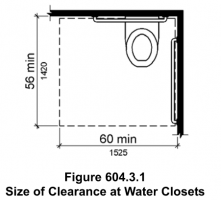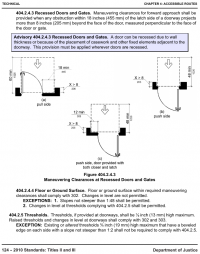DTBarch
SAWHORSE
Question:
Does the grab bar below prohibitively encroach into the door's 18" maneuvering clearance? There is a code snap (A4.24.2.5) that I found online that seems to exempt grab bar overlap for required clear floor space, but unsure of the code source. The actual horizontal clearance between the end of the grab bar and the door swing is approx. 12 inches. The door has a closer. Plan reviewer has an issue with it. Is this a discussion with "clear floor space" versus "maneuvering clearance"??


Does the grab bar below prohibitively encroach into the door's 18" maneuvering clearance? There is a code snap (A4.24.2.5) that I found online that seems to exempt grab bar overlap for required clear floor space, but unsure of the code source. The actual horizontal clearance between the end of the grab bar and the door swing is approx. 12 inches. The door has a closer. Plan reviewer has an issue with it. Is this a discussion with "clear floor space" versus "maneuvering clearance"??





